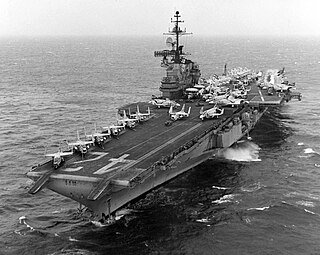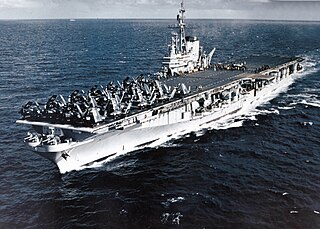
USS Oriskany (CV/CVA-34),, was one of the few Essex-class aircraft carriers completed after World War II for the United States Navy. The ship was named for the Battle of Oriskany during the Revolutionary War.

USS Saratoga (CV-3) was a Lexington-class aircraft carrier built for the United States Navy during the 1920s. Originally designed as a battlecruiser, she was converted into one of the Navy's first aircraft carriers during construction to comply with the Washington Naval Treaty of 1922. The ship entered service in 1928 and was assigned to the Pacific Fleet for her entire career. Saratoga and her sister ship, Lexington, were used to develop and refine carrier tactics in a series of annual exercises before World War II. On more than one occasion these exercises included successful surprise attacks on Pearl Harbor, Hawaii. She was one of three prewar US fleet aircraft carriers, along with Enterprise and Ranger, to serve throughout World War II.

USS Ticonderoga (CV/CVA/CVS-14) was one of 24 Essex-class aircraft carriers built during World War II for the United States Navy. The ship was the fourth US Navy ship to bear the name, and was named after the capture of Fort Ticonderoga in the American Revolutionary War. Ticonderoga was commissioned in May 1944, and served in several campaigns in the Pacific Theater of Operations, earning five battle stars. Decommissioned shortly after the end of the war, she was modernized and recommissioned in the early 1950s as an attack carrier (CVA), and then eventually became an antisubmarine carrier (CVS). She was recommissioned too late to participate in the Korean War, but was very active in the Vietnam War, earning three Navy Unit Commendations, one Meritorious Unit Commendation, and 12 battle stars.

USS Randolph (CV/CVA/CVS-15) was one of 24 Essex-class aircraft carriers built during World War II for the United States Navy. The second US Navy ship to bear the name, she was named for Founding Father Peyton Randolph, president of the First Continental Congress. Randolph was commissioned in October 1944, and served in several campaigns in the Pacific Theater of Operations, earning three battle stars. Decommissioned shortly after the end of the war, she was modernized and recommissioned in the early 1950s as an attack carrier (CVA), and then eventually became an antisubmarine carrier (CVS).

USS Hancock (CV/CVA-19) was one of 24 Essex-class aircraft carriers built during World War II for the United States Navy. Hancock was the fourth US Navy ship to bear the namesake of Founding Father John Hancock, president of the Second Continental Congress and first governor of the Commonwealth of Massachusetts. Hancock was commissioned in April 1944 and served in several campaigns in the Pacific Theater of Operations, earning four battle stars. Decommissioned shortly after the end of the war, she was modernized and recommissioned in the early 1950s as an attack carrier (CVA). In her second career, she operated exclusively in the Pacific, playing a prominent role in the Vietnam War, for which she earned a Navy Unit Commendation. She was the first US Navy carrier to have steam catapults installed. She was decommissioned in early 1976 and sold for scrap later that year.

USS Franklin D. Roosevelt (CVB/CVA/CV-42) was the second of three Midway-class aircraft carriers. To her crew, she was known as "Swanky Franky," "Foo-De-Roo," or "Rosie," with the last nickname probably the most popular. Roosevelt spent most of her active deployed career operating in the Mediterranean Sea as part of the United States Sixth Fleet. The ship was decommissioned in 1977 and was scrapped shortly afterward. She was the first aircraft carrier of the United States Navy to be named in honor of a president of the United States.

The flight deck of an aircraft carrier is the surface from which its aircraft take off and land, essentially a miniature airfield at sea. On smaller naval ships which do not have aviation as a primary mission, the landing area for helicopters and other VTOL aircraft is also referred to as the flight deck. The official U.S. Navy term for these vessels is "air-capable ships".

The Midway-class was a class of three United States Navy aircraft carriers. The lead ship, USS Midway, was commissioned in September 1945 and decommissioned in 1992. USS Franklin D. Roosevelt was commissioned in October 1945, and taken out of service in 1977. USS Coral Sea was commissioned in April 1947, and decommissioned in 1990.

The Forrestal-class aircraft carriers were four aircraft carriers designed and built for the United States Navy in the 1950s. The class ship was named for James Forrestal, the first United States Secretary of Defense. It was the first class of supercarriers, combining high tonnage, deck-edge elevators and an angled deck. The first ship was commissioned in 1955, the last decommissioned in 1998. The four ships of the class were scrapped in Brownsville, Texas, between 2014 and 2017.

The Spruance-class destroyer was developed by the United States to replace the many World War II–built Allen M. Sumner- and Gearing-class destroyers, and was the primary destroyer built for the United States Navy during the 1970s and 1980s. It was named in honor of U.S. Navy Admiral Raymond A. Spruance, who successfully led major naval battles in the Asiatic-Pacific Theater during World War II such as the Battle of Midway and the Battle of the Philippine Sea.
Taihō was an aircraft carrier of the Imperial Japanese Navy during World War II. Possessing heavy belt armor and featuring an armored flight deck, she represented a major departure from prior Japanese aircraft carrier design and was expected to not only survive multiple bomb, torpedo, or shell hits, but also continue fighting effectively afterwards.

Aquila was an Italian aircraft carrier converted from the transatlantic passenger liner SS Roma. During World War II, Work on Aquila began in late 1941 at the Ansaldo shipyard in Genoa and continued for the next two years. With the signing of the Italian armistice on 8 September 1943, however, all work was halted and the vessel remained unfinished. She was captured by the National Republican Navy of the Italian Social Republic and the German occupation forces in 1943, but in 1945 she was partially sunk by a commando attack of Mariassalto, an Italian royalist assault unit of the Co-Belligerent Navy of the Kingdom of Italy, made up by members of the former Decima Flottiglia MAS. Aquila was eventually refloated and scrapped in 1952.
Amagi (天城) was an Unryū-class aircraft carrier built for the Imperial Japanese Navy during World War II. Named after Mount Amagi, and completed late in the war, she never embarked her complement of aircraft and spent the war in Japanese waters. The ship capsized in July 1945 after being hit multiple times during airstrikes by American carrier aircraft while moored at Kure Naval Base. Amagi was refloated in 1946 and scrapped later that year.

The Japanese aircraft carrier Unryū was the lead ship of her class of fleet aircraft carriers built for the Imperial Japanese Navy (IJN) during World War II. She was commissioned in mid-1944, but fuel and aircrew shortages limited her use to Japanese waters. The impending American invasion of Luzon caused the IJN to order her to transport aircraft and supplies to the Philippines in December. The ship was torpedoed and sunk by the American submarine USS Redfish in the East China Sea during the voyage.

SCB-125 was the United States Navy designation for a series of upgrades to the Essex class of aircraft carriers planned by the Ship Characteristics Board and conducted between 1954 and 1959. These upgrades included the addition of an angled flight deck and other enhancements aimed at improving flight operations and seakeeping.

The aircraft cruiser is a warship that combines the features of the aircraft carrier and a surface warship such as a cruiser or battleship.

The Graf Zeppelin-class aircraft carriers were four German Kriegsmarine aircraft carriers planned in the mid-1930s by Grand Admiral Erich Raeder as part of the Plan Z rearmament program after Germany and Great Britain signed the Anglo-German Naval Agreement. They were planned after a thorough study of Japanese carrier designs. German naval architects ran into difficulties due to lack of experience in building such vessels, the situational realities of carrier operations in the North Sea and the lack of overall clarity in the ships' mission objectives.

Katsuragi (葛城) was the third and final Unryū-class aircraft carrier of the Imperial Japanese Navy built during World War II. Named after Mount Katsuragi, in Nara Prefecture, and completed late in the war; she never embarked her complement of aircraft and spent the war in Japanese waters. The ship was badly damaged in a July 1945 airstrike by American carrier aircraft on Kure Naval Base. Repaired after the end of the war, Katsuragi was then used as a repatriation transport for a number of months, bringing Japanese soldiers and civilians back to Japan from overseas locations. She was scrapped in Japan beginning in late 1946.
An armoured flight deck is an aircraft carrier flight deck that incorporates substantial armour in its design.

The Essex class was a class of aircraft carriers of the United States Navy. The 20th century's most numerous class of capital ship, the class consisted of 24 vessels, which came in "short-hull" and "long-hull" versions. Thirty-two ships were ordered, but as World War II wound down, six were canceled before construction, and two were canceled after construction had begun. Fourteen saw combat during World War II. None were lost to enemy action, though several sustained crippling damage. Essex-class carriers were the backbone of the U.S. Navy from mid-1943 and, with the three Midway-class carriers added just after the war, continued to be the heart of U.S. naval strength until supercarriers joined the fleet in the 1950s, 1960s and 1970s. Several of the carriers were rebuilt to handle heavier and faster aircraft of the early jet age, and some served until well after the Vietnam War.

















